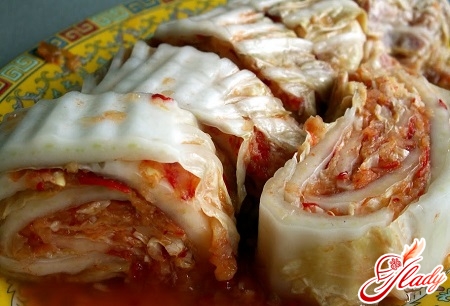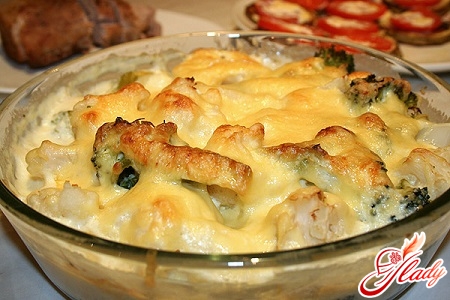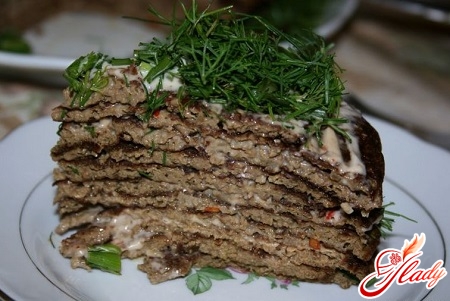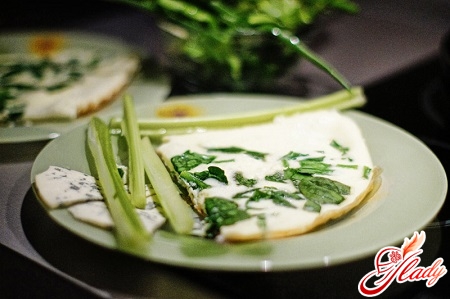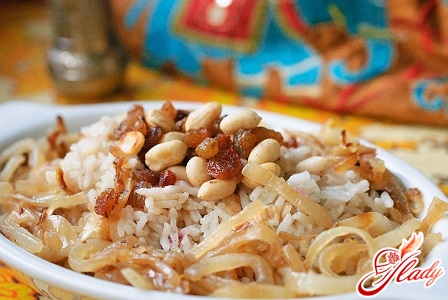
Such a popular dish today, like pilaf, leavesroots in the prehistoric past so that to determine even a century of its origin can be very conditional. If we assume that the most common plov recipe "came" with the beginning of rice cultivation in the Middle East (II-III century BC), then in China this culture began to grow much earlier. And yet, the Chinese traditions of rice consumption have nothing to do with pilaf, especially if it's a pilaf with raisins. Most likely, the homeland of the vegetarian species is India, where slaughter was equated with the murder of a person. And already the meat was brought into the recipe of the Persians.
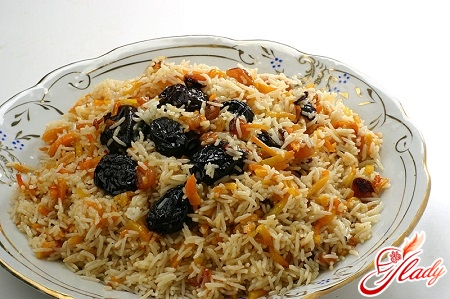
Of what is the correct pilaf
Today, there are thousands of pilaf recipes, andTo determine which of them is the most correct, it is unlikely to succeed. Judging by the name, the main ingredient of this dish is rice, as the name itself translates to "boiled rice". For many people, the dish is called similarly: in India - the sexes, in Bulgaria - Pilaf, in Uzbekistan - palov. When preparing a dish such as pilaf with raisins, it should be understood that it is not so important what products contain the recipe, how much the cooking technology itself. Since pilaf has migrated to Russia from Uzbekistan, according to the Uzbek recipe, it consists of two components: zirvak (a mixture of onions, carrots, meat, fruits, seasonings) and rice proper. Sweet pilaf with raisins can be cooked with or without meat. Even if a meat dish, first of all, a bow is sent to the cauldron with hot oil. Since in Uzbekistan pilaf is cooked on cotton vegetable oil, it is customary to throw initially a small whole bulb, which is brought to blackness and absorbs unpleasant smells of oil. Sunflower oil, alas, can not be recoiled in this way. Therefore, simply fried onions, cut into rings or semicircles, until golden. This will determine the color of the prepared dish. Some people prefer to fry carrots first, which is taken about as much as rice. And this is also true, because this vegetable also contributes to the rich yellow color of the plova.Only after these two ingredients, meat is put, if the prescription initially presupposes its presence. If not, then you can add spices to pilaf. Perhaps they are at home in the mixture bought in the store. However, acquiring them, you should pay attention to the composition. After all, European manufacturers sometimes add to the package something that is completely unrelated to the true seasonings for pilaf. Although the tastes do not argue. 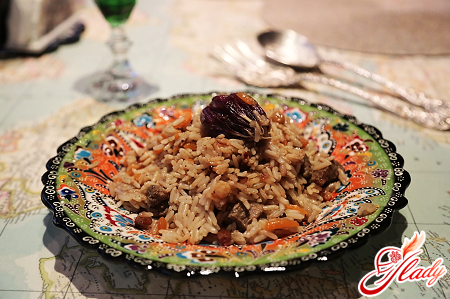
Spices for pilaf: European or Asian
Traditional oriental pilaf suggestsadd zira (zera, zry) in the form of whole grains, berries barberry, turmeric, lobules or whole heads of garlic. The main thing is not to overdo it with seasonings. At the same time, the pre-washed raisins are added. In some recipes, it is advisable to pour water on the ingredients and boil for 5 minutes, but this is not necessary. When a dirwak prepares with elderly meat, then, naturally, he needs time to get ready after pre-frying. But pilaf without meat does not need additional cooking, because all the ingredients are prepared quickly enough. And now a rich aroma is spread from the dense soup. It remains only to send the rice.
A little bit about the proportions: rice and water
From him, and should start, not in the sense of selfpreparation, and preparation for pilaf. Because the difference between pilaf and ordinary porridge is that the rice is decocted, and not welded to the viscosity. Therefore, the groats need to be thoroughly rinsed, and the grinding dust removed from it, so that the grains become translucent. It is usually enough to stop the rice under running water or three times to change the water, in which the croup should lie for hours 2 for swelling. No need to pour rice with hot water, and so, after 2 hours, it will perfectly come to the condition for 20-25 minutes. Although the recipe with such advice is not uncommon. Many people care about the proportion of rice and water. And indeed, because this pilaff is distinguished by loose structure, which can not be achieved by every hostess. It is better to be guided not by the volume of rice, but by how much the liquid level exceeds the surface of rice. Water should cover the rump only 1 cm. Specialists recommend to bring the water first to a boil on high heat, and then reduce to the weakest. Sometimes it seems that this liquid is small, because it evaporates quickly when the pilon boils boiling. However, one should not rush to add more water. It is better to pierce and slightly push the rice, making small depressions to the bottom of the cauldron. After 8-10 minutes, these grooves should be leveled and done elsewhere. So gradually the rice will come to the ready. Yes, and stir the pilaf is strictly prohibited. Do not rush to shoot the sample. Even having turned off the stove, you need to wrap the cauldron with a towel around the edge of the lid, not letting out a pair. Let the ready dish take another 10-15 minutes - then a rich, crumbly plov is provided. The recipe for such a simple vegetarian plov is called Bukhara, it is laid out beautifully on a large flat dish (lagan) with a slide and sprinkled with pomegranate seeds. A lot depends on the aesthetic appearance. Despite the fact that the dish has a sweetish taste, it is usually eaten with a radish salad. It is not forbidden to dream up and add dried apricots or pumpkin to raisins. A pleasant taste is given by quince. And if the vegetarian pilaf is satiated with chickpeas, then there will be no equal for him.




